You have an Azure DevOps project that contains a build pipeline. The build pipeline uses approximately 50 open source libraries.
You need to ensure that all the open source libraries comply with your company's licensing standards.
Which service should you use?
Answer:
C
Secure and Manage Open Source Software
Black Duck helps organizations identify and mitigate open source security, license compliance and code-quality risks across application and container portfolios.
Black Duck Hub and its plugin for Team Foundation Server (TFS) allows you to automatically find and fix open source security vulnerabilities during the build process, so you can proactively manage risk. The integration allows you to receive alerts and fail builds when any Black Duck Hub policy violations are met.
Note: WhiteSource would also be a good answer, but it is not an option here.
Reference:
https://marketplace.visualstudio.com/items?itemName=black-duck-software.hub-tfs
DRAG DROP -
You plan to use Azure Kubernetes Service (AKS) to host containers deployed from images hosted in a Docker Trusted Registry.
You need to recommend a solution for provisioning and connecting to AKS. The solution must ensure that AKS is RBAC-enabled and uses a custom service principal.
Which three commands should you recommend be run in sequence? To answer, move the appropriate commands from the list of commands to the answer area and arrange them in the correct order.
Select and Place: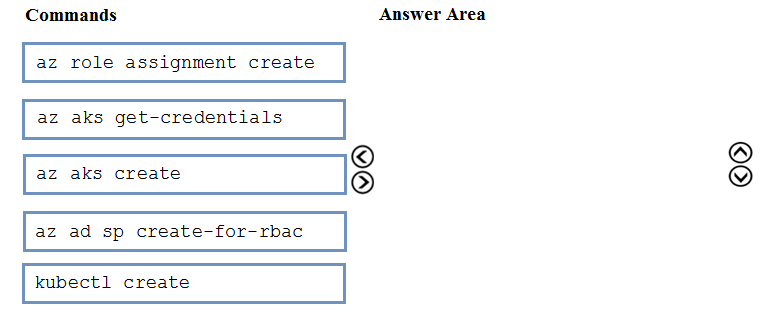
Answer:
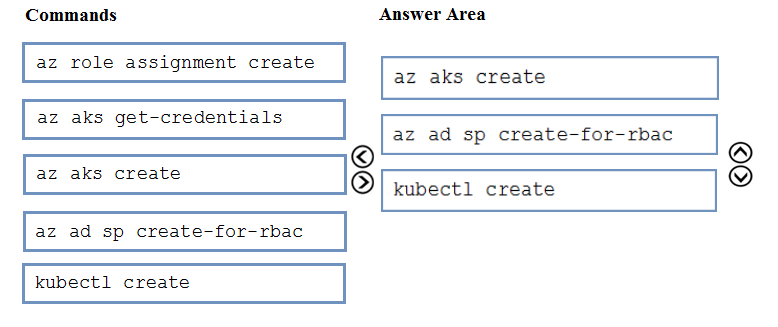
Step 1 : az acr create -
An Azure Container Registry (ACR) can also be created using the new Azure CLI. az acr create
--name <REGISTRY_NAME>
--resource-group <RESOURCE_GROUP_NAME>
--sku Basic
Step 2: az ad sp create-for-rbac
Once the ACR has been provisioned, you can either enable administrative access (which is okay for testing) or you create a Service Principal (sp) which will provide a client_id and a client_secret. az ad sp create-for-rbac
--scopes /subscriptions/<SUBSCRIPTION_ID>/resourcegroups/<RG_NAME>/providers/Microsoft.ContainerRegistry/registries/<REGISTRY_NAME>
--role Contributor
--name <SERVICE_PRINCIPAL_NAME>
Step 3: kubectl create -
Create a new Kubernetes Secret.
kubectl create secret docker-registry <SECRET_NAME>
--docker-server <REGISTRY_NAME>.azurecr.io
--docker-email <YOUR_MAIL>
--docker-username=<SERVICE_PRINCIPAL_ID>
--docker-password <YOUR_PASSWORD>
Reference:
https://thorsten-hans.com/how-to-use-private-azure-container-registry-with-kubernetes
Your company develops an app for iOS. All users of the app have devices that are members of a private distribution group in Microsoft Visual Studio App Center.
You plan to distribute a new release of the app.
You need to identify which certificate file you require to distribute the new release from App Center.
Which file type should you upload to App Center?
Answer:
C
A successful IOS device build will produce an ipa file. In order to install the build on a device, it needs to be signed with a valid provisioning profile and certificate.
To sign the builds produced from a branch, enable code signing in the configuration pane and upload a provisioning profile (.mobileprovision) and a valid certificate (.p12), along with the password for the certificate.
Reference:
https://docs.microsoft.com/en-us/appcenter/build/xamarin/ios/
SIMULATION -
You need to prepare a network security group (NSG) named az400-123456789-nsg1 to host an Azure DevOps pipeline agent. The solution must allow only the required outbound port for Azure DevOps and deny all other inbound and outbound access to the Internet.
To complete this task, sign in to the Microsoft Azure portal.
Answer:
See explanation below.
1. Open Microsoft Azure Portal and Log into your Azure account.
2. Select network security group (NSG) named az400-123456789-nsg1
3. Select Settings, Outbound security rules, and click Add
4. Click Advanced
5. Change the following settings:
✑ Destination Port range: 8080
✑ Protocol. TCP
✑ Action: Allow
Note: By default, Azure DevOps Server uses TCP Port 8080.
Reference:
https://robertsmit.wordpress.com/2017/09/11/step-by-step-azure-network-security-groups-nsg-security-center-azure-nsg-network/ https://docs.microsoft.com/en-us/azure/devops/server/architecture/required-ports?view=azure-devops
DRAG DROP -
You have a project in Azure DevOps named Project1 that contains two Azure DevOps pipelines named Pipeline1 and Pipeline2.
You need to ensure that Pipeline1 can deploy code successfully to an Azure web app named webapp1. The solution must ensure that Pipeline2 does not have permission to webapp1.
Which three actions should you perform in sequence? To answer, move the appropriate actions from the list of actions to the answer area and arrange them in the correct order.
Select and Place:
Answer:
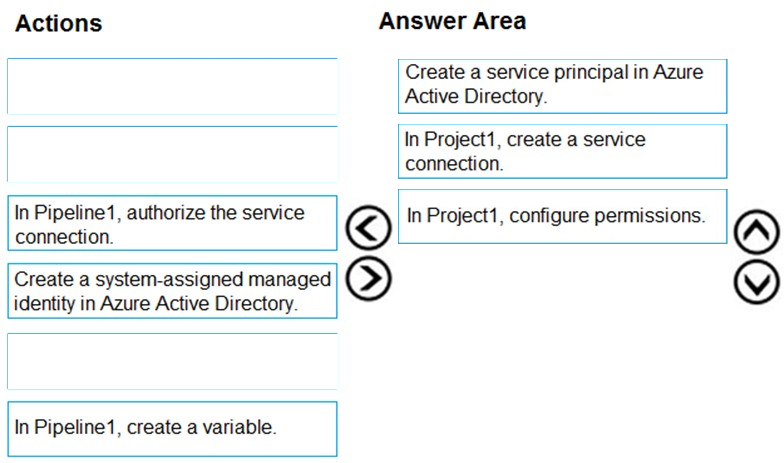
Reference:
https://docs.microsoft.com/en-us/azure/devops/pipelines/library/connect-to-azure?view=azure-devops
DRAG DROP -
You need to increase the security of your team's development process.
Which type of security tool should you recommend for each stage of the development process? To answer, drag the appropriate security tools to the correct stages. Each security tool may be used once, more than once, or not at all. You may need to drag the split bar between panes or scroll to view content.
NOTE: Each correct selection is worth one point.
Select and Place: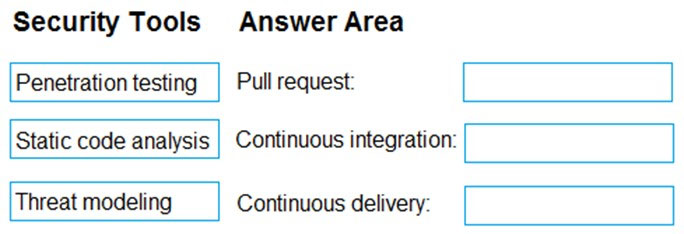
Answer:
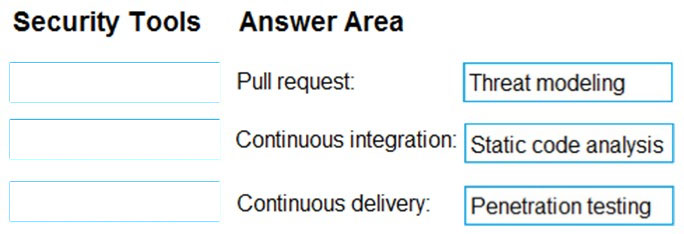
Box 1: Threat modeling -
Threat modeling's motto should be, ג€The earlier the better, but not too late and never ignore.ג€
Box 2: Static code analysis -
Validation in the CI/CD begins before the developer commits his or her code. Static code analysis tools in the IDE provide the first line of defense to help ensure that security vulnerabilities are not introduced into the CI/CD process.
Box 3: Penetration testing -
Once your code quality is verified, and the application is deployed to a lower environment like development or QA, the process should verify that there are not any security vulnerabilities in the running application. This can be accomplished by executing automated penetration test against the running application to scan it for vulnerabilities.
Reference:
https://docs.microsoft.com/en-us/azure/devops/articles/security-validation-cicd-pipeline?view=vsts
Your company is concerned that when developers introduce open source libraries, it creates licensing compliance issues.
You need to add an automated process to the build pipeline to detect when common open source libraries are added to the code base.
What should you use?
Answer:
D
WhiteSource provides WhiteSource Bolt, a lightweight open source security and management solution developed specifically for integration with Azure DevOps and Azure DevOps Server.
Note: WhiteSource is the leader in continuous open source software security and compliance management. WhiteSource integrates into your build process, irrespective of your programming languages, build tools, or development environments. It works automatically, continuously, and silently in the background, checking the security, licensing, and quality of your open source components against WhiteSource constantly-updated definitive database of open source repositories.
Note:
There are several versions of this question in the exam. The question has two possible correct answers:
1. Black Duck
2. WhiteSource Bolt
Other incorrect answer options you may see on the exam include the following:
1. Microsoft Visual SourceSafe
2. PDM
3. SourceGear
4. SourceGear Vault
Reference:
https://www.azuredevopslabs.com/labs/vstsextend/whitesource/
You plan to use a NuGet package in a project in Azure DevOps. The NuGet package is in a feed that requires authentication.
You need to ensure that the project can restore the NuGet package automatically.
What should the project use to automate the authentication?
Answer:
B
The Azure Artifacts Credential Provider automates the acquisition of credentials needed to restore NuGet packages as part of your .NET development workflow. It integrates with MSBuild, dotnet, and NuGet(.exe) and works on Windows, Mac, and Linux. Any time you want to use packages from an Azure Artifacts feed, the
Credential Provider will automatically acquire and securely store a token on behalf of the NuGet client you're using.
Reference:
https://github.com/Microsoft/artifacts-credprovider
You use Azure Pipelines to manage project builds and deployments.
You plan to use Azure Pipelines for Microsoft Teams to notify the legal team when a new build is ready for release.
You need to configure the Organization Settings in Azure DevOps to support Azure Pipelines for Microsoft Teams.
What should you turn on?
Answer:
A
The Azure Pipelines app uses the OAuth authentication protocol, and requires Third-party application access via OAuth for the organization to be enabled. To enable this setting, navigate to Organization Settings > Security > Policies, and set the Third-party application access via OAuth for the organization setting to On.
Reference:
https://docs.microsoft.com/en-us/azure/devops/pipelines/integrations/microsoft-teams
You have an existing project in Azure DevOps.
You plan to integrate GitHub as the repository for the project.
You need to ensure that Azure Pipelines runs under the Azure Pipelines identity.
Which authentication mechanism should you use?
Answer:
B
GitHub App uses the Azure Pipelines identity.
Incorrect Answers:
A: Personal access token and OAuth use your personal GitHub identity.
Reference:
https://docs.microsoft.com/en-us/azure/devops/pipelines/repos/github